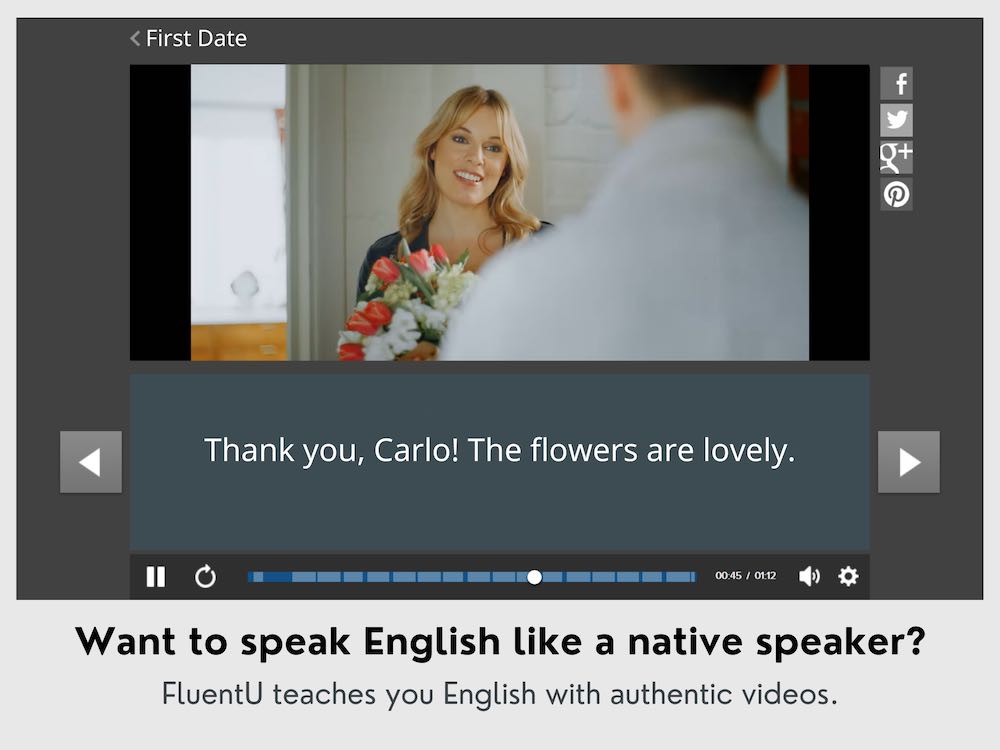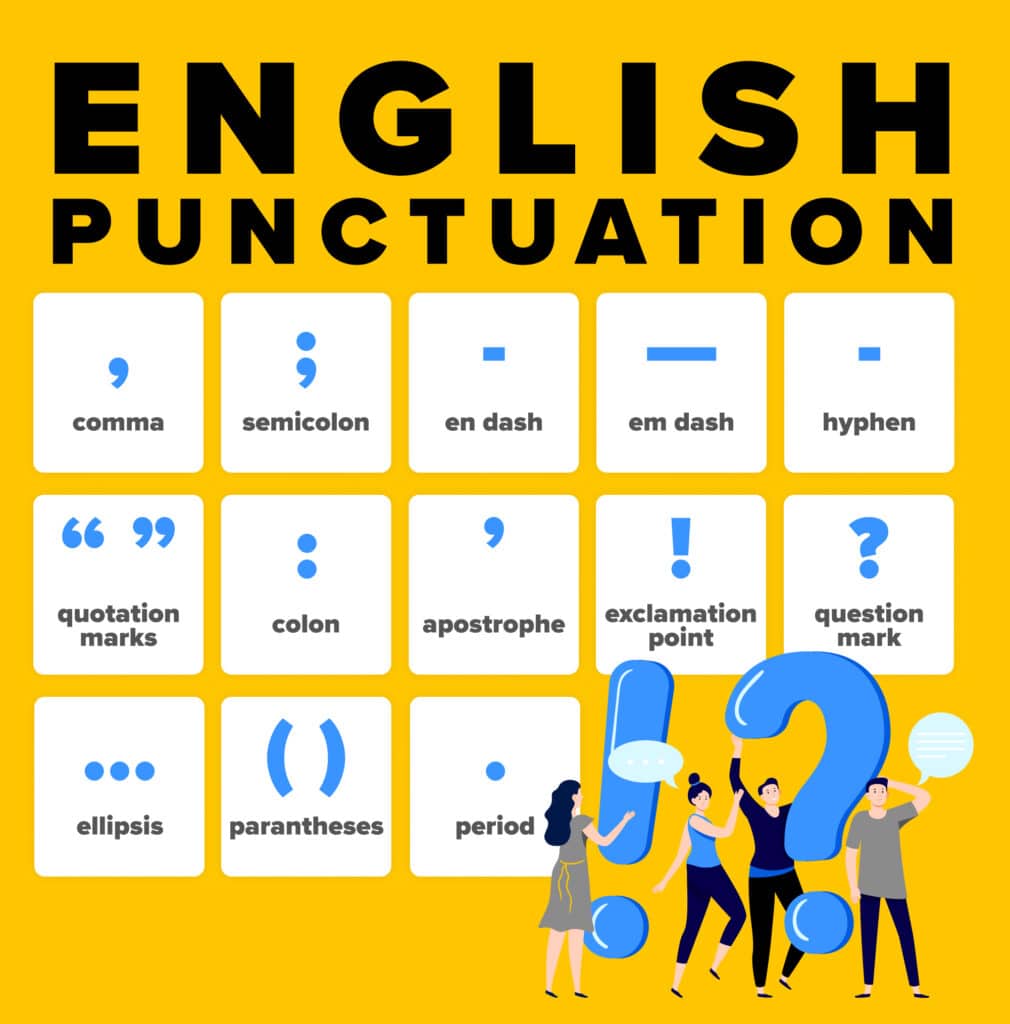
The Ultimate Guide to English Punctuation Marks
Punctuation mistakes can cost millions of dollars.
Just ask the dairy company that lost a lawsuit due to a missing comma.
Fortunately, with a little practice, they can become a valuable tool in your English learning toolbox.
In this post, I’ll show you how to use 13 of the most important English punctuation marks.
Contents
- Comma: ,
- Semicolon: ;
- En Dash: –
- Em Dash: —
- Hyphen: –
- Ellipsis: …
- Quotation Marks: ” “
- Colon: :
- Apostrophe: ‘
- Question mark: ?
- Exclamation point: !
- Parentheses: ( )
- Period: .
- Resources for English Punctuation Practice
- And One More Thing...
Download: This blog post is available as a convenient and portable PDF that you can take anywhere. Click here to get a copy. (Download)
Here’s a handy reference guide to the punctuation marks:
Comma: ,
Commas are the jack of all trades of the punctuation marks. They introduce sentences, separate list items and make long sentences more digestible, among other roles. They give space and rhythm to ideas.
No wonder commas are the most widely used English punctuation mark after the period. There are many different ways to use commas correctly, making it a mostly misused and relatively difficult mark.
Here are some of its most essential uses:
- Separating elements in a series:
He served us chips, salsa, popcorn, nuts and drinks while we watched the game.
- Preceding conjunctions (like “and,” “but,” “yet,” etc.) that sit between two independent clauses:
My friends went to the arcade, but I stayed home with a fever.
- Following dependent clauses that introduce a sentence:
Since I was early, I stopped to have a cup of coffee.
Common mistakes to avoid:
Watch out for the unnecessary comma! Mistakes like these are everywhere. Whenever you have one independent clause followed directly by a dependent clause or you’re using constructions like “either… or,” you don’t need commas.
Wrong: My fish died, after it got sick.
Correct: My fish died after it got sick.
Wrong: You either hate pineapple pizza, or you love it.
Correct: You either hate pineapple pizza or you love it.
Semicolon: ;
Semicolons are the scariest punctuation marks in the English language. Even native speakers are often confused about how to use them.
But have no fear! Once you take the time to learn, you’ll see that there are only a few simple uses for this punctuation mark.
Semicolons link two related sentences. They also separate complex list items and separate list items with commas.
For example:
We were planning to have dinner tonight; we had to cancel it when her boss called.
My mother visited Nairobi, in Kenya; Tokyo, in Japan; and São Paulo, in Brazil.
Common mistakes to avoid:
Perhaps the most common semicolon mistake is using it with dependent clauses. You should only use a semicolon between clauses that can stand independently as sentences.
Wrong: I have so much on my to-do list tomorrow; plus all my homework.
Correct: I have so much on my to-do list tomorrow plus all my homework.
En Dash: –
This is perhaps the least well-known punctuation mark. The en dash is a design and publishing mark used to connect related values in a range. A good rule to remember is to use it to replace “to” or “through” when we’re talking about time, pages or sports scores.
Examples:
The 1998–2000 season was the best for the NY Yankees.
Please read the story in pages 9–13.
Common mistakes to avoid:
Many English speakers (including native speakers) confuse the en dash with the em dash or hyphen (discussed below). Note that the em dash is a little bit wider.
Also, be sure not to add a space on either side of the dash.
Wrong: I’m arriving on the Boston – Washington flight.
Correct: I’m arriving on the Boston–Washington flight.
But honestly, unless you’re preparing some formal print material, you shouldn’t concern yourself too much with the en dash.
Em Dash: —
As noted above, the em dash is a bit wider than the en dash (the width of a letter “M” instead of “N,” hence their names), so it’s easier to identify.
The em dash is generally used to create variety and complexity in your sentences. It can also help clarify important ideas, sometimes replacing a comma or parentheses.
If you’re confident you understand how parentheses work, you should master the em dash really quickly.
There are basically three ways to use the em dash:
- To interject a clause to add emphasis
- To clarify when adding details
- To indicate an interruption
Examples:
The girl—the one with long, blond hair—looked beautiful on the stage.
Attendees must cover their own lodging costs—hotel room, food and beverages.
He said, “I thought you should—” “I should do what?!” she replied.
Common mistakes to avoid:
Most common mistakes regarding the em dash tend to be related to spaces before or after them.
Wrong: Andrea preferred traveling to Europe — Italy and Spain — rather than South America.
Correct: Andrea preferred traveling to Europe—Italy and Spain—rather than South America.
Hyphen: –
Hyphens end our confusion trifecta along with the dashes. They’re important especially when we’re describing lengths of time and ages.
While dashes are used to mostly separate words, hyphens join words together or add prefixes/suffixes onto words.
Examples:
Jim is a well-liked neighbor.
My great-grandmother was a famous scientist.
He wants to be a co-author on the book.
Common mistakes to avoid:
There are plenty of mistakes to avoid while using hyphens, but one of the most common is to simply use them or neglect them at the wrong times. As a general rule, you should use hyphens to connect words that modify a noun if the noun comes second.
Correct: The vegan-friendly restaurant is just around the corner.
Correct: This restaurant is vegan friendly.
Ellipsis: …
Ellipses (plural of ellipsis) are those three little dots you see when someone’s typing you a text (…). But they’ve been a widely used punctuation mark since way before the iPhone.
Ellipses are quite simple, actually. We use ellipses mostly to indicate omissions or interrupted speech. For example, if you’re quoting a long speech but you only want to focus on an important idea and not the whole text, you use ellipses to indicate where you’ve shortened words or sentences. Take a look at this famous speech from John F. Kennedy:
“And so, my fellow Americans, ask not what your country can do for you; ask what you can do for your country. My fellow citizens of the world, ask not what America will do for you, but what, together, we can do for the freedom of man.”
We can use ellipses to focus on the idea we want to share and indicate that there are some omissions:
“And so, my fellow Americans, ask not what your country can do for you; ask what you can do for your country… ask not what America will do for you, but what, together, we can do for the freedom of man.”
What about interrupted speech? We use ellipses when we wish to express a brief pause in a sentence or just a break in the flow of it.
Example:
Let me think about your problem… actually, don’t! You think; it’s your problem.
Common mistakes to avoid:
The most common mistakes with ellipses are:
- Trailing off for no reason: “It’s not a problem for us to meet on Monday…”
- Or simply using more than three dots: “And then John fell asleep…..”
Quotation Marks: ” “
Although there are a few ways to use quotation marks, they’re often misused. They’re mostly used to quote someone else’s words verbatim (exactly). But they’re also good to indicate sarcasm, irony or to cite a media piece like a song, book or TV show.
For example:
King Edward said, “I’ll have my best men on the subject.”
Amy Pond is a character in “Doctor Who.”
Common mistakes to avoid:
Don’t use quotation marks when you’re summarizing or paraphrasing someone else’s words.
Wrong: King Edward said that “he’ll have his best men on the subject.”
Correct: King Edward said that he’ll have his best men on the subject.
Note that quotation marks are used differently in American and British English. In the U.K., single quotation marks (‘) are used instead of double quotation marks.
Colon: :
Colons are fantastic punctuation marks for several purposes.
They’re good for introducing lists, connecting thoughts and adding complexity and variety to your sentences.
Examples:
She only likes three candy bars: Snickers, Three Musketeers, Milky Way.
This semester, I’m taking two courses: biology and chemistry.
Common mistakes to avoid:
Colons are frequently used incorrectly alongside the phrases “for example” or “such as.” You don’t need both.
Wrong: Your outline should cover the parts of your essay, such as: goals, methods…
Correct: Your outline should cover the parts of your essay, such as goals, methods…
You also don’t use colons after a preposition.
Wrong: The mayor announced cutbacks in: research funding, staff development…
Correct: The mayor announced cutbacks in research funding, staff development…
Apostrophe: ‘
You mostly need apostrophes to show possession or to spell contractions (English words created by combining two separate words).
For example:
The man’s sister took a train to meet us.
Don’t forget to vote!
Common mistakes to avoid:
The most common mistake with apostrophes is using them incorrectly with the words “it’s” and “its.”
“It’s” is a contraction that means “it is.” In contrast, “its” is a possessive pronoun.
Wrong: The dog pulled on it’s leash. (This sentence really says, “The dog pulled on it is leash.”)
Correct: The dog pulled on its leash.
Remember that you also don’t need a second “s” if you’re using an apostrophe on a word that ends in “s.”
Wrong: He wrapped all the kids’s presents in 20 minutes.
Correct: He wrapped all the kids’ presents in 20 minutes.
Question mark: ?
A question mark is a punctuation symbol used to indicate the end of a sentence that asks a question.
For example:
Where do you live?
Are you coming to the party?
Common mistakes to avoid:
The most common mistake to avoid with question marks is using them where it’s not necessary. It should only be used at the end of an actual question and not a statement that implies a question.
Wrong: I wonder if she’s coming?
Correct: I wonder if she’s coming.
Keep in mind that using multiple question marks doesn’t add emphasis to a question and can make a sentence appear unprofessional: “Why are you running late??“
Exclamation point: !
An exclamation point is used when you need to show strong emotions like excitement, surprise or when you need to emphasize something.
For example:
Wow! That’s amazing!
I can’t believe it!
Common mistakes to avoid:
Don’t use a question mark or period after the exclamation point even when the sentence asks a direct question. It should be used alone at the end of a sentence.
Wrong: How long are you going to take to get ready?!
Correct: How did you come up with this great idea!
Don’t put a comma after the exclamation point with quotations.
Wrong: “Give it back to me right now!,” he yelled.
Correct: “Give it back to me right now!” he yelled.
Parentheses: ( )
Parentheses are used to enclose additional information or clarify a point within a sentence. They provide information or explanations that can be helpful but aren’t essential to the main sentence.
For example:
The company (founded in 1995) has experienced significant growth in recent years.
She is an accomplished musician (trained in classical piano and guitar) who performs regularly.
Common mistakes to avoid:
The most common mistakes with parentheses are:
- Overusing parentheses
- Failing to close parentheses: “I have three favorite colors (blue, green, red.”
Period: .
And finally, there’s no better way to end this guide than with the period. Periods are the most common punctuation marks and are mainly used to end sentences.
However, you may also see periods when they’re used in abbreviations and acronyms.
For example:
U.S.A. stands for United States of America.
Mr. is the abbreviation for Mister.
Common mistakes to avoid:
The most common mistakes to avoid with periods involve not the marks themselves but the spaces after them.
Don’t put a space before a period at the end of a sentence.
Wrong: My pants are ruined .
Correct: My pants are ruined.
And, generally speaking, don’t put more than one space after the period if it’s followed by another sentence. (However, note that some types of academic writing require two spaces after a period.)
Wrong: I’m driving to the town. The town is five miles south.
Correct: I’m driving to the town. The town is five miles south.
Resources for English Punctuation Practice
Our guide above gave you a strong foundation in English punctuation. If you want a handy reference to continue learning and practicing, check these out:
- “Penguin Guide to Punctuation:” This inexpensive book is a useful guide for any student who needs to use proper punctuation when writing.
- English Oxford Living Dictionaries: This website provides practical guidance on how to use punctuation marks, with many examples and answers to common questions.
- Grammarly: This is an invaluable resource for learning punctuation while actively improving your writing. Grammarly is an instant spell- and grammar-checker that you can use while you write anything from emails to Facebook posts and more.
Grammarly won’t just point out your punctuation mistakes (and many other types of mistakes), but will also give you reports and explanations. That means you won’t make the same mistake next time.
- FluentU: This tool lets you watch English language videos with interactive subtitles so you can see how punctuation marks are used in real-life conversations and scenarios.
FluentU takes authentic videos—like music videos, movie trailers, news and inspiring talks—and turns them into personalized language learning lessons.
You can try FluentU for free for 2 weeks. Check out the website or download the iOS app or Android app.
P.S. Click here to take advantage of our current sale! (Expires at the end of this month.)

- Education First: This website provides several articles on punctuation to help you communicate in a more clear, organized way. You’ll see that it comes with plenty of usage examples, too.
If you want to learn more about English abbreviations, check out this blog post:
English Abbreviations: What They Are, How They Work and Common Examples | FluentU English Blog
English abbreviations are one kind of words that you’ll always be learning in English, there’re hunders of them! This blog post is an essential guide to English…
So, those are the most common uses for English punctuation marks and the mistakes you should avoid while using them. Now that you know them, all there’s left to do is to practice!
Get to it!
Download: This blog post is available as a convenient and portable PDF that you can take anywhere. Click here to get a copy. (Download)
And One More Thing...
If you like learning English through movies and online media, you should also check out FluentU. FluentU lets you learn English from popular talk shows, catchy music videos and funny commercials, as you can see here:
The FluentU app and website makes it really easy to watch English videos. There are captions that are interactive. That means you can tap on any word to see an image, definition, and useful examples.
For example, when you tap on the word "searching," you see this:
Learn all the vocabulary in any video with quizzes. Swipe left or right to see more examples for the word you’re learning.

FluentU helps you learn fast with useful questions and multiple examples. Learn more.
The best part? FluentU remembers the vocabulary that you’re learning. It gives you extra practice with difficult words—and reminds you when it’s time to review what you’ve learned. You have a truly personalized experience.
Start using the FluentU website on your computer or tablet or, better yet, download the FluentU app from the iTunes or Google Play store. Click here to take advantage of our current sale! (Expires at the end of this month.)












